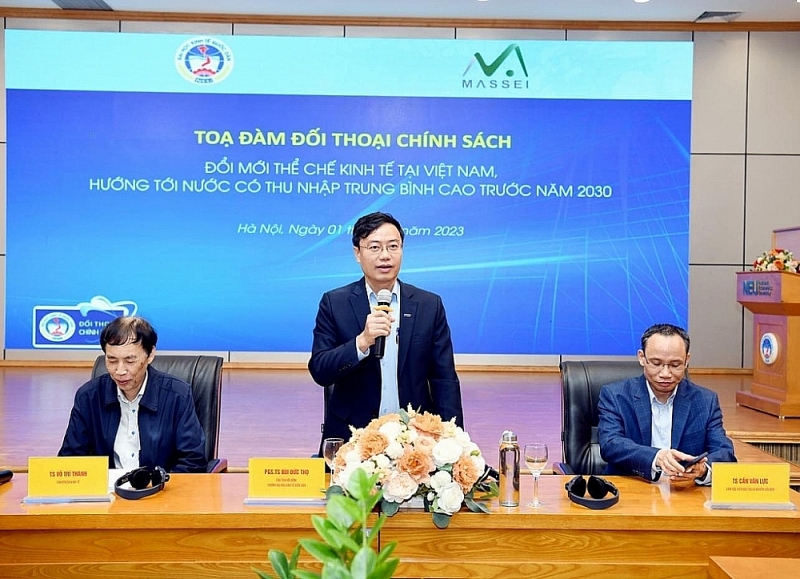 |
| Experts speaking at the seminar. |
According to statistics of the World Bank (WB), the per capita income (GNI/capita) of Vietnam in 2021 is estimated at US $ 3,590. With this income level, Vietnam is approaching the starting point of the group of upper-middle-income countries (according to the World Bank’s classification).
However, at the Policy Dialogue: “Innovation of economic institutions in Vietnam, towards a high average income country by 2030” co-organized by the National Economics University and the Fraser Institute (Canada) held on March 1, experts said when most countries reach this threshold, the growth rate slows down, many economic uncertainties appear to be of a fundamental structure, which is very difficult to solve, while facing many problems of population aging, social security, environmental degradation, resource depletion, etc.
As a result, only very few countries have overcome their middle-income trap to become developed and high-income countries.
Prof. Dr. Pham Hong Chuong, Rector of the National Economics University, said that out of 101 middle-income countries in the 1960s, only 13 became high-income countries in 2008.
“This practice shows that in order to turn aspiration into reality, Vietnam must continue on the path that has proven to be successful over the past 30 years, which is developing a modern market economy and integrating into the world,” Prof. Dr. Pham Hong Chuong said.
According to experts at the seminar, since previous economic crises, it was not the demand stimulus programs and public investment that brought about economic development achievements in the following years, but the reform of economic institutions.
Dr. Fred McMahon, Head of Research on Economic Freedom at the Fraser Institute (Canada), said that in order for Vietnam to maintain a fast growth rate, economic policy must become more competitive.
Vietnam has a strategic geographical position, people are increasingly disciplined and educated, along with the economic model is transforming, so Vietnam will become a high-income country.
For a more specific analysis of the solution, Mr. Dinh Tuan Minh, Research Director of the Center for Researching Market Solutions for Socio-Economic Issues, said that a breakthrough is needed in two factors: maintaining good currency by continuing to persist in stabilizing the macroeconomy, and ensuring stable inflation at 3-4% in recent years.
According to Mr. Minh, it is necessary to study and review the exchange rate regime, allowing individual investors to participate in the foreign exchange market at exchanges, thereby improving the criterion of “freedom of ownership of foreign currency at the bank”.
In particular, on trade, Mr. Dinh Tuan Minh said, it is necessary to review non-tariff barriers in a clear, transparent and stable manner. At the same time, the authorities must persist in reforming administrative procedures in the customs field to reduce time costs and facilitate trade.
In terms of finance, this expert emphasized solutions to control capital, making Vietnam’s capital market more attractive to foreign investors.
Relating to finance, economic expert Dr. Can Van Luc recommends urgently completing the legal corridor, in which it is necessary to focus on legalizing the handling of bad debts; supplementing models, mechanisms and regulations to manage and supervise financial groups, new business models based on technology; adopting policies to encourage and promote the management and development of the corporate bond market, new financial institutions such as voluntary pension funds, real estate investment funds, and venture funds, etc.
“Improving the financial market institution to ensure healthy and sustainable development and improving the competitiveness of the financial system is a key factor in perfecting the market economy institutions,” Dr. Can Van Luc said.
